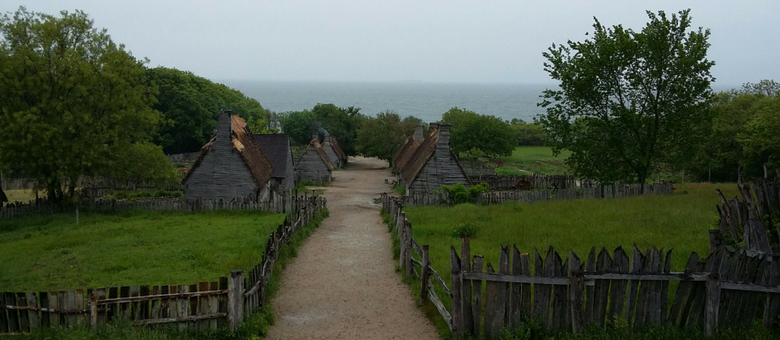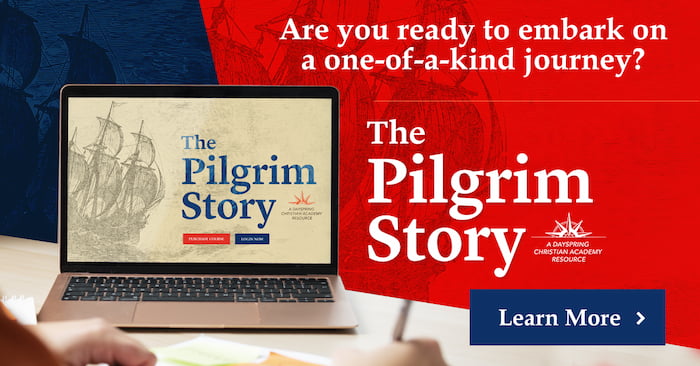If are considering Dayspring Christian Academy, or if you are a Dayspring Parent and you’ve never been on this field study with your child, or maybe you’ve never heard of Dayspring…it doesn’t matter… I’m writing this blog for you. I first journeyed to Plymouth in May of 2014. It was our family’s first year at Dayspring Christian Academy. We had only enrolled two of our four children to “test the waters.” Both of my children had a good first year, and I was slowly getting to know other families. The Plymouth trip is the annual third-grade four-day field study. It is the culmination of their unit of study on the Pilgrims in history class. My daughter and I were both very much looking forward to the trip. She, especially, was excited about having four days with me all to herself!
Day One: The Journey and The Monument
Boarding a tour bus, students, teachers, and parents traveled to Plymouth. Along the way, we watched two videos: Desperate Crossing by the History Channel and Kirk Cameron’s Monumental. Coming from a public school elementary experience and a Mennonite school middle and high school experience, sadly, did not afford me the opportunity to learn the full Pilgrim story. These two videos were my introduction to the Pilgrims and a small glimpse of what I was about to experience over the next few days.
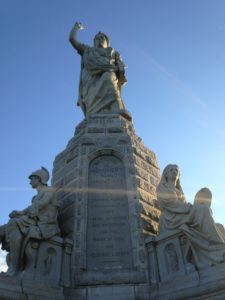 Arriving early evening gave us ample time to visit the National Monument to the Forefathers, the first stop on the trip. Made of granite and standing 81 feet tall, the monument faces sister city, Plymouth, England. It was here that the first of many teaching sessions began. Standing next to my daughter, I listening intently as Mrs. Mary Stauffer, our tour leader and Pilgrim expert, described each aspect of the monument and its meaning. I was astounded that so much meaning could be carved into stone and saddened that our world nowadays has become so shallow and we’ve forgotten so much. Little did I know, I would feel similar feelings over and over as my eyes were opened more and more. It was like a door opening and I could see the richness of our nation’s Christian history for the first time. It was here that I began to understand the ramifications of my decision to send my children to Dayspring — that the richness of the method of education, the Principle Approach, would make all other forms of education pale in comparison.
Arriving early evening gave us ample time to visit the National Monument to the Forefathers, the first stop on the trip. Made of granite and standing 81 feet tall, the monument faces sister city, Plymouth, England. It was here that the first of many teaching sessions began. Standing next to my daughter, I listening intently as Mrs. Mary Stauffer, our tour leader and Pilgrim expert, described each aspect of the monument and its meaning. I was astounded that so much meaning could be carved into stone and saddened that our world nowadays has become so shallow and we’ve forgotten so much. Little did I know, I would feel similar feelings over and over as my eyes were opened more and more. It was like a door opening and I could see the richness of our nation’s Christian history for the first time. It was here that I began to understand the ramifications of my decision to send my children to Dayspring — that the richness of the method of education, the Principle Approach, would make all other forms of education pale in comparison.
Day Two: A Walking Tour Of Plymouth
The next day, we were scheduled to take a walking tour of Plymouth with stops at various landmarks and monuments along the way. It was a wonderful day that included stops at Pilgrim Hall Museum, the Jenney Gristmill, the Jenney Museum (a Dayspring favorite!) Burial Hill, Cole’s Hill, the Mayflower II, Brewster Gardens and more! At each stop, students were encouraged to journal (and draw) what they learned.
Watching my daughter write in her journal at each stop we made, as small as it seems, brought me great joy. As I watched her document her learning, I was grateful that the journal is a requirement of the trip. First and foremost, people who journal their experiences tend to recall what they learned for a longer period of time and with better clarity. Secondly, the journal inspired deeper conversations between my daughter and me. We discussed her thoughts on the things she was learning, as well as the Lord and His ways. Our four-day trip to Plymouth is still something we talk about, as our bond as mother and daughter was strengthened greatly through this trip.
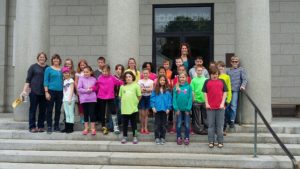 Pilgrim Hall is our nation’s oldest continuously operating museum. Here, we got to see William Bradford’s Bible, Myles Standish’s sword, the cradle of the first child born in New England, Peregrine White, the great chair of William Brewster, and much more. At the conclusion of our time in Pilgrim Hall, students recited the Mayflower Compact from the exterior steps of the building. I loved that the museum’s staff commented that this was their favorite part of having Dayspring visit the museum. They loved that our students knew the Mayflower Compact by heart!
Pilgrim Hall is our nation’s oldest continuously operating museum. Here, we got to see William Bradford’s Bible, Myles Standish’s sword, the cradle of the first child born in New England, Peregrine White, the great chair of William Brewster, and much more. At the conclusion of our time in Pilgrim Hall, students recited the Mayflower Compact from the exterior steps of the building. I loved that the museum’s staff commented that this was their favorite part of having Dayspring visit the museum. They loved that our students knew the Mayflower Compact by heart!
Before Dayspring and this first trip to Plymouth, I did not know what the Mayflower Compact was and how this seemingly benign agreement between the Pilgrims and their fellow travelers would lay the groundwork for our Founding Fathers to later draft our Constitution. I remember feeling that now-familiar sense of loss upon discovering that I had not been taught the full Pilgrim story. Surely, if I did not know this despite both a public and Christian school education, how many others too lack this knowledge? And what does this lack of understanding of our Christian history mean for the future of our nation?
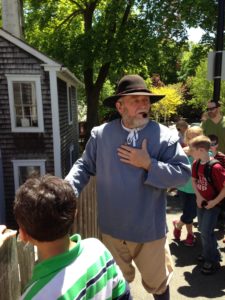 The second day of our trip brought the introduction of Leo the Miller. Leo owns and operates the Jenney Museum right next to the Jenney Gristmill. Leo was our guide and teacher for about two hours, delighting us with his knowledge and challenging us as Christian parents to raise our children to reason from Biblical truth so they may carry on the legacy the Pilgrims left for us.
The second day of our trip brought the introduction of Leo the Miller. Leo owns and operates the Jenney Museum right next to the Jenney Gristmill. Leo was our guide and teacher for about two hours, delighting us with his knowledge and challenging us as Christian parents to raise our children to reason from Biblical truth so they may carry on the legacy the Pilgrims left for us.
The afternoon quickly passed as our group learned more and more about the fight for truth in Plymouth. Reflective of our nation as a whole, Plymouth is in a struggle to keep her Christian history alive. This can be seen on several of the more recent monuments and landmarks as the Pilgrim story documented so clearly in William Bradford’s journal, Of Plimoth Plantation are altered to be politically correct.
There were two lessons that were emblazoned on my heart that afternoon in Plymouth. The first came from a Latin inscription on Bradford’s gravestone: “What our fathers with so much difficulty attained, do not basely relinquish.” The second came while sitting atop Cole’s Hill, praying for our nation. It was cemented into my heart that it is the responsibility of every American believer to pray for our nation to be restored to its Christian foundation. Together, these two lessons remind me that I have been given the blessings of liberty and that liberty came at very high cost. If I want to keep that liberty, I must fight for it in prayer, in how I raise my children, in how I vote, and in any other way the Lord leads.
Day Three: Plimoth Plantation
On day three, we boarded the bus for Plimoth Plantation. My daughter and I were very excited to see what the plantation would’ve looked like, talk to the actors, visit the Wampanoag homesite, and (of course) visit the gift shop. The students were divided into groups prior to the trip and tasked with researching a specific aspect of plantation life. The categories included food, housing, medical care, defense, and much more. Students had to interview both Wampanoag and Pilgrims to gather information then present this information to the class the next day. On this first trip, our group’s category was food.
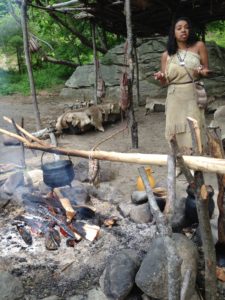 We began in the Wampanoag Homesite. In talking to two Wampanoag ladies, we learned not only what types of foods they ate, but how they hunted and how they grew their food. Our whole group was enthralled and engaged and we quickly realized that without the help of the Wampanoag, the Pilgrims certainly would have perished. It was as Bradford said, “Squanto continued with [the Pilgrims] and was their interpreter and was a special instrument sent of God for their good beyond their expectation. He directed them how to set their corn, where to take fish, and to procure other commodities, and was also their pilot to bring them to unknown places for their profit, and never left them till he died.”
We began in the Wampanoag Homesite. In talking to two Wampanoag ladies, we learned not only what types of foods they ate, but how they hunted and how they grew their food. Our whole group was enthralled and engaged and we quickly realized that without the help of the Wampanoag, the Pilgrims certainly would have perished. It was as Bradford said, “Squanto continued with [the Pilgrims] and was their interpreter and was a special instrument sent of God for their good beyond their expectation. He directed them how to set their corn, where to take fish, and to procure other commodities, and was also their pilot to bring them to unknown places for their profit, and never left them till he died.”
That afternoon, our group journeyed up to the plantation where we were able to interview actors in character representing the Pilgrims that had come over on the Mayflower. Our students had been trained and prepared to ask the actors questions that would yield responses congruent with the time period. This was a fun yet challenging task for both students and parents!
As evening approached, the students, teachers, and parents gathered together for a traditional Pilgrim meal, reminiscent of the first Thanksgiving. We were then treated to Pilgrim stories, Pilgrim games, and even the opportunity to write with feather pens and ink, in Pilgrim script.
Day Four: Heading Home
Morning brought breakfast (of course!) with the group project presentations immediately following. Many of the projects were skits infused with comedy which resulted in boisterous fits of laughter! We were then given one last chance to tour the plantation and native settlement before boarding the bus to head for home.
After a wonderful four days of learning, the trip home seemed long, but many parents, including myself, reflected on the knowledge we had gained. I heard many parents say “I wish I had been taught this way.”
 Over the next few days, my daughter worked on adding photos and finishing details to the journal she had kept. We reminisced together and shared our experiences with others. As I enrolled my other two kids in Dayspring, I could not wait for my husband and son to journey to Plymouth. And I was already greatly anticipating a return trip myself.
Over the next few days, my daughter worked on adding photos and finishing details to the journal she had kept. We reminisced together and shared our experiences with others. As I enrolled my other two kids in Dayspring, I could not wait for my husband and son to journey to Plymouth. And I was already greatly anticipating a return trip myself.
That return Plymouth trip happened this past May 2017. My second daughter and I spent four days with her class in Plymouth. While I had heard these lessons once before, the richness of the teaching and of our nation’s history was not at all lost on me. My decision to educate our children at Dayspring Christian Academy and the challenge to pray for our nation were further solidified in my mind.
Alongside the incredible teaching on this trip, I’ve been blessed to experience what it must be like in my child’s classroom. Being inspired to learn and challenged to reason from God’s Word are just two of many experiences. There’s one other aspect that I’ve been able to experience through this trip: worship.
Each night on the Plymouth trip, the group gathers for a devotional time with worship before bed. Have you ever been in a room of 9-year-olds who are singing their hearts out to the Lord? It brings tears to my eyes every time I get this opportunity. The Bible tells us to “Shout joyfully to God, all the earth; Sing the glory of His name; Make His praise glorious.” (Psalm 66:1-2). The Bible also tells us that “David praised the Lord in the presence of the whole assembly” (1 Chronicles 29:10a). May we never stifle our worship because we are afraid of what others think of us!
Plymouth, From A Student’s Perspective
Since I’ve told you my perspective of my Plymouth trip experiences, I thought it would be fun to ask some former third graders (including my daughters) a few questions about their Plymouth experience:
What was your favorite part of the trip?
7th grader: Drinking out of the springs our forefathers. It’s amazing to me that the springs are still there – they haven’t been polluted or covered.
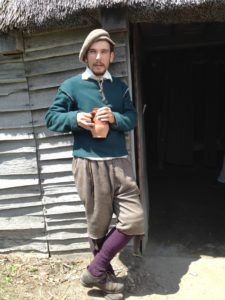 4th grader #1: Plimoth Plantation – we got to talk to characters like Edward Winslow and William Brewster, and William Bradford.
4th grader #1: Plimoth Plantation – we got to talk to characters like Edward Winslow and William Brewster, and William Bradford.
4th grader #2: Plimoth Plantation – I enjoyed talking to the pilgrims and the Native Americans.
6th grader: Watching the Mayflower be tugged into port (on his Plymoth trip, my son and his class had the unique opportunity to see the Mayflower II return from Mystic Seaport, CT where she had undergone repairs).
What was the most exciting thing you learned?
7th grader: The Pilgrims were more than just people that came to America. They actually came to spread the gospel.
4th grader #2: That only one woman had a baby on the Mayflower. His name was Oceanus.
4th grader #1: I was excited to learn how the pilgrims and the natives worked together.
6th grader: How the natives played football!
What advice would you have for a parent attending this trip?
7th grader: Make sure you charge your phone at night. You’ll need it for photos!
4th grader #2: That you’ll see a lot of really cool stuff like the Mayflower.
6th grader: Bring snacks, bring money so your son or daughter can buy something at the gift shop.
DCA: Anything else you’d like to add?
7th grader: The Plymouth trip is a fun trip. You’ll learn a lot about the Pilgrims. We do learn a lot in class but we actually get to go and see where these things happened. You get to see all of the landmarks and get to see how big the Mayflower actually was and how far they traveled from the Mayflower to the shore, and from the shore to the plantation.
Conclusion
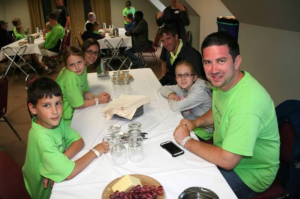 The Plymouth trip is just one of many educational field studies that parents are encouraged to attend with their children. While I can’t contain all of my thoughts and experiences in one blog post, I can say that the decision to send my children to Dayspring Christian Academy is not only shaping their character, strengthening their relationships with the Lord, and preparing them for their futures, it is shaping my character, my relationship with the Lord, and my future, too. Long after my kids are grown, I’ll have these precious memories and this priceless knowledge to carry with me. And, for that, I’m forever grateful.
The Plymouth trip is just one of many educational field studies that parents are encouraged to attend with their children. While I can’t contain all of my thoughts and experiences in one blog post, I can say that the decision to send my children to Dayspring Christian Academy is not only shaping their character, strengthening their relationships with the Lord, and preparing them for their futures, it is shaping my character, my relationship with the Lord, and my future, too. Long after my kids are grown, I’ll have these precious memories and this priceless knowledge to carry with me. And, for that, I’m forever grateful.
If you would like to learn more about Dayspring Christian Academy, please call Karol Hasting at 717-285-2000 or use the button below to schedule a tour.
